Customers are looking for the help they need with minimal effort. In fact, only 9% of customers who have a low effort customer service experience report being disloyal to that company. That’s compared to 96% who have a high effort experience.
Front puts the focus squarely on helping teams manage their shared inboxes. Their customers include Dropbox, Culture Amp, SalesLoft, and Zumper.
91% of customers who have a low effort customer service experience remain loyal to that company.
What Makes Front Popular?
The user interface is familiar and intuitive, so teams can get set up quickly. Front makes it easy for users to manage both their personal and shared inboxes in the same place.
They’ve clearly put a lot of thought into their collaboration tools, including shared drafts and tasks. Teams can collaborate without getting tangled up in a web of forwarded emails and CCs. Agents can even opt to share personal emails with the rest of the team when they need to collaborate or troubleshoot.
Front also supports social channels and SMS so customers can get in touch using their favorite channel. Customers expect fast responses to queries on all channels, and Front’s social media integration helps your team offer those quick answers.
It’s not just social, either. Front offers strong integration with popular sales software like Salesforce and Hubspot, along with custom plugins.
Why Are Businesses Looking For Front Competitors?
Being able to bring together personal and professional email sounds exciting at first. But it only works in the long term if your customer service tool is fully compatible with your email provider. Customers report messages that they send, file, or erase from Gmail aren’t always synchronized with the Front inbox. This can be tricky if you need to keep track of what was done via which inbox, and can leave some businesses looking for Front alternatives.
Managing ongoing support threads is a challenge because everything looks like an email, and it’s not always clear when an issue should be “closed.”
Front’s ticketing system isn’t robust enough for teams with higher ticket volumes. Some teams of 50 or bigger have noticed performance issues. It’s also expensive for bigger teams (10 or more.) When you add in the fact that all pricing plans require a commitment of a year in advance, it can be difficult to grow your team with Front.
The more affordable price points still only offer limited workflow customizations. Teams that need customized workflows will likely find Front isn’t flexible enough.
The basic plan also doesn’t offer even basic analytics to measure performance and ticket volume. Integration with other systems requires users to have a user account with those systems, which can be a hindrance if you’re using SSO. Many integrations such as Intercom or Pipedrive are not two-way.
7 Front Alternatives To Try
There are plenty of simpler and more affordable customer support solutions out there. You don’t have to compromise on functionality, either - there’s a solution for most needs.
Let’s take a look at some Front alternatives to help you decide which is the best fit for your team. Here are our 7 top picks for Front alternatives.
1. Enchant
Enchant has been designed from the ground up with ease of use in mind. The product is similar to Front in many ways and offers a range of features to help you take care of your customers. Enchant is a great Front Alternative if you want something more affordable and yet powerful.
Enchant boasts an intuitive interface that will seem familiar if you’ve used common business tools like Gmail. That means a shallow learning curve, so your team can get started right away. Enchant is suited to teams from 3 - 300, so there’s plenty of room to grow.
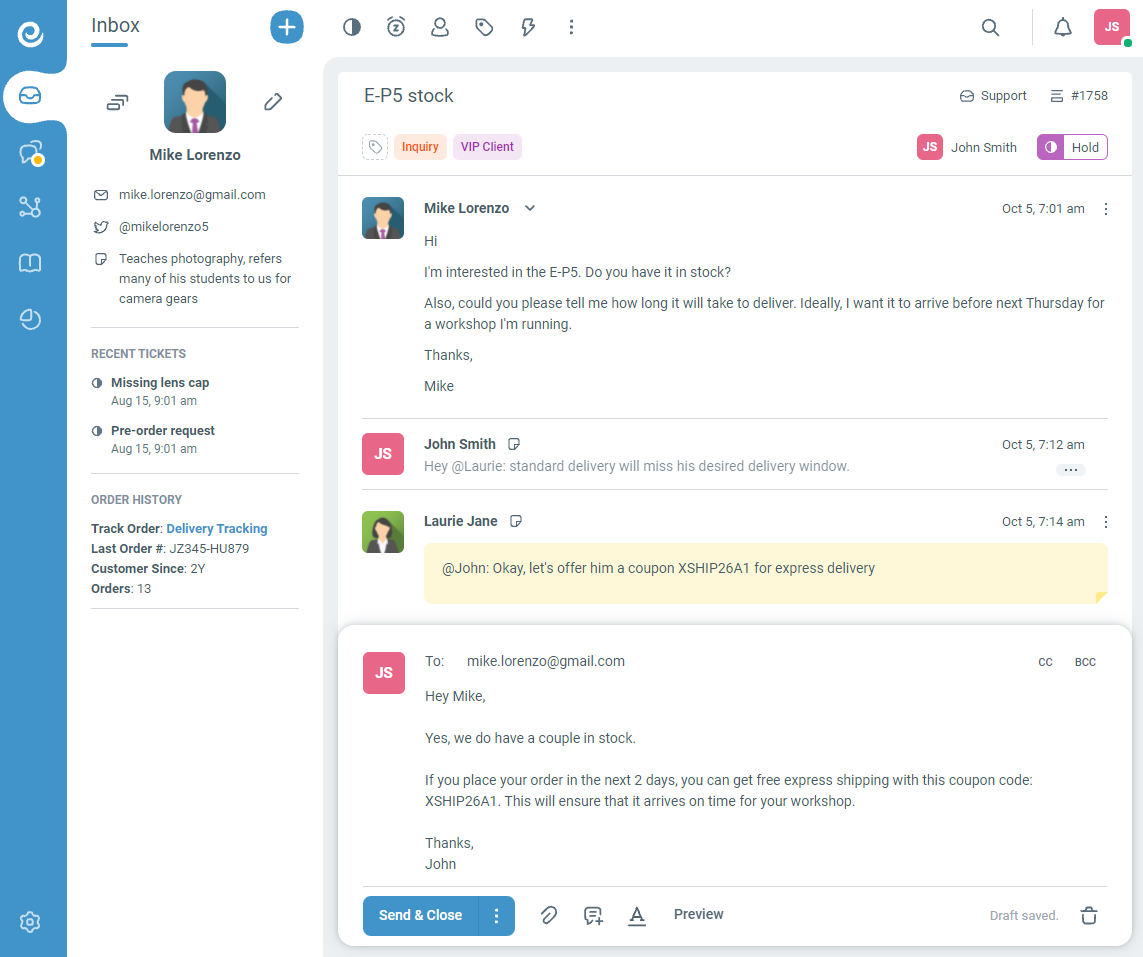
Enchant has been around for over a decade now. Of course we may be a bit biased, but we stand by the quality of our product and our commitment to our customers’ success. The flexible features include a robust set of workflow customizations, to fit teams from a variety of different industries.
With built-in automation and collaboration tools your team can keep their focus on delivering excellent customer service. Many of our customers migrated from Front and have successfully grown their businesses with Enchant, and you can too!
What Enchant offers:
- Shared inboxes with customizable folders, automations, and collaboration tools.
- Built-in live chat and knowledge base for quick answers. Great for customers who want to resolve their issues without speaking to an agent.
- Customer Satisfaction Ratings (CSAT) so it’s easy to find out how happy your customers are.
- Omnichannel support - receive and respond to customers via voice calls, SMS, WhatsApp, Facebook Messenger and Instagram channels.
- AI Response Writer that generates replies based on your knowledge base and past conversations.
- In-depth analysis and reports that give you insights on trends, team performance, and customer satisfaction.
- Easy integration with popular apps such as Shopify, Slack and many more.
- Simple, affordable pricing: $20 per user, per month. No annual contracts or nasty surprises.
Pros:
- No ticket numbers or log-ins means Enchant is invisible to customers. They only see the stellar customer service they receive!
- Easy and intuitive interface.
- Get set up quickly, with no need for additional training.
- Multiple inboxes with their own permissions and settings. Handle requests individually, or in a single unified queue.
- Manage all your brands and departments separately, but through one single account.
- Supports over 20 languages.
Cons:
- No customer forums or customer dashboard.
- Pro-active messaging is not supported.
2. Zendesk
If you're looking for Front alternatives, Zendesk is unbeatable when it comes to features. It is robust and reliable. Any major enterprise level business on the hunt for a help desk will find Zendesk meets most if not all of their needs.
Zendesk's features include a shared inbox, knowledge base, live chat, and customer satisfaction tools. They provide both social and phone support even on their starting plan. They also offer detailed analytics and reports you can use to improve your customer service.
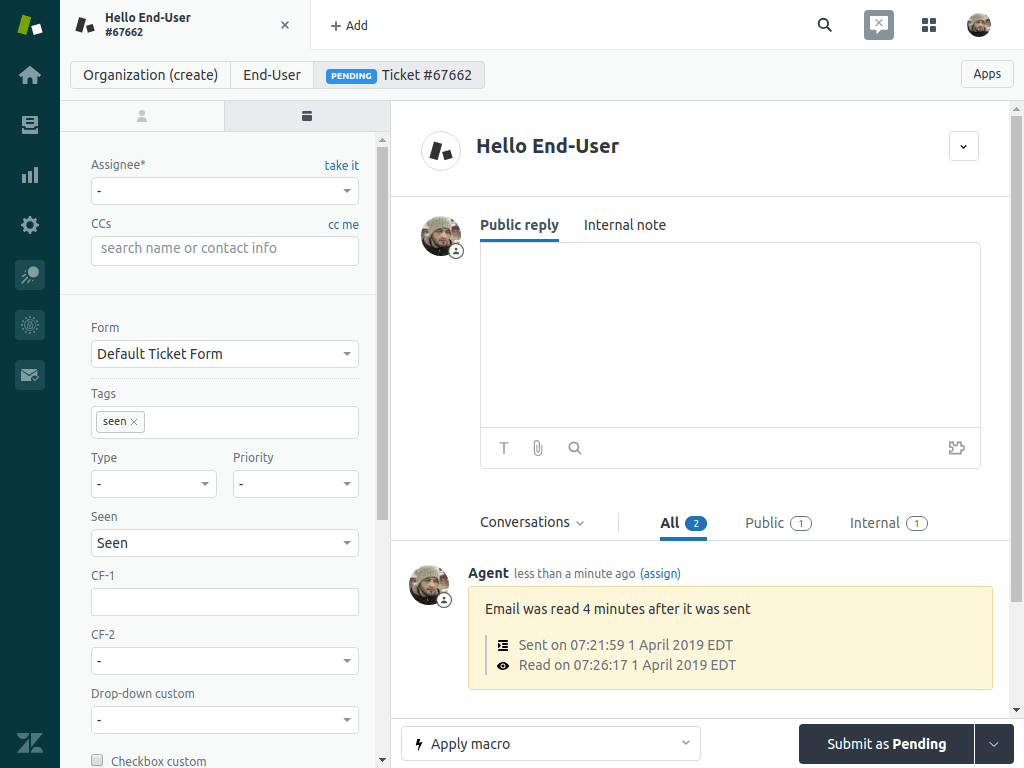
The higher priced Zendesk Suite plan provides sales and marketing features alongside the support management ones. But some users don't need all those features. The sheer amount of functionality can make Zendesk feel bulky and complex. And it isn't exactly affordable for small-mid size businesses as you could end up paying for features you don't need. Many customers also complain that the software evolves very slowly due to its behemoth size.
The interface is also old fashioned and lacks that modern, intuitive feel that some users are looking for.
What Zendesk offers:
- Omnichannel support, including social media.
- A self-service knowledge base so customers can find their own answers without contacting an agent.
- Support for phone calls, and a live chat widget.
- CRM, customer portals, and community forums.
- Reports and integrations.
Pros:
- You can get phone and social channel support even on the lowest plan.
- Robust analytics and reporting capabilities help you make data-backed decisions.
- An advanced CRM with flexible customizations.
- A wide range of integrations with other apps and services.
- If you have the budget to invest more, Zendesk suite gives you added sales and lead tracking features.
Cons:
- The product is bloated and complicated enough that agents need training on how to use it.
- Basic features such as customer satisfaction ratings are only available at higher price points.
- It's not affordable for small - medium sized businesses or bootstrapping startups.
- There's a lack of features available on the mobile app.
- Some customers complain about delays of more than 10 minutes receiving inbound emails.
- Some customers also point out that the user interface can be glitchy.
- Chat and email tickets have their own queues, so it doesn't really feel like you're using one single tool.
3. Freshdesk
If you’re looking for Front alternatives, Freshdesk is another strong player when it comes to features. Its simpler and more straightforward interface is a plus. You can auto-assign requests based on agent skills, load-balancing, or a round robin sequence. You’ll also find tools for better collaboration with field service teams.
Despite its simpler look, Freshdesk packs in a wide variety of large enterprise features. It’s one of the most popular Front competitors with those who still need large enterprise functionality.
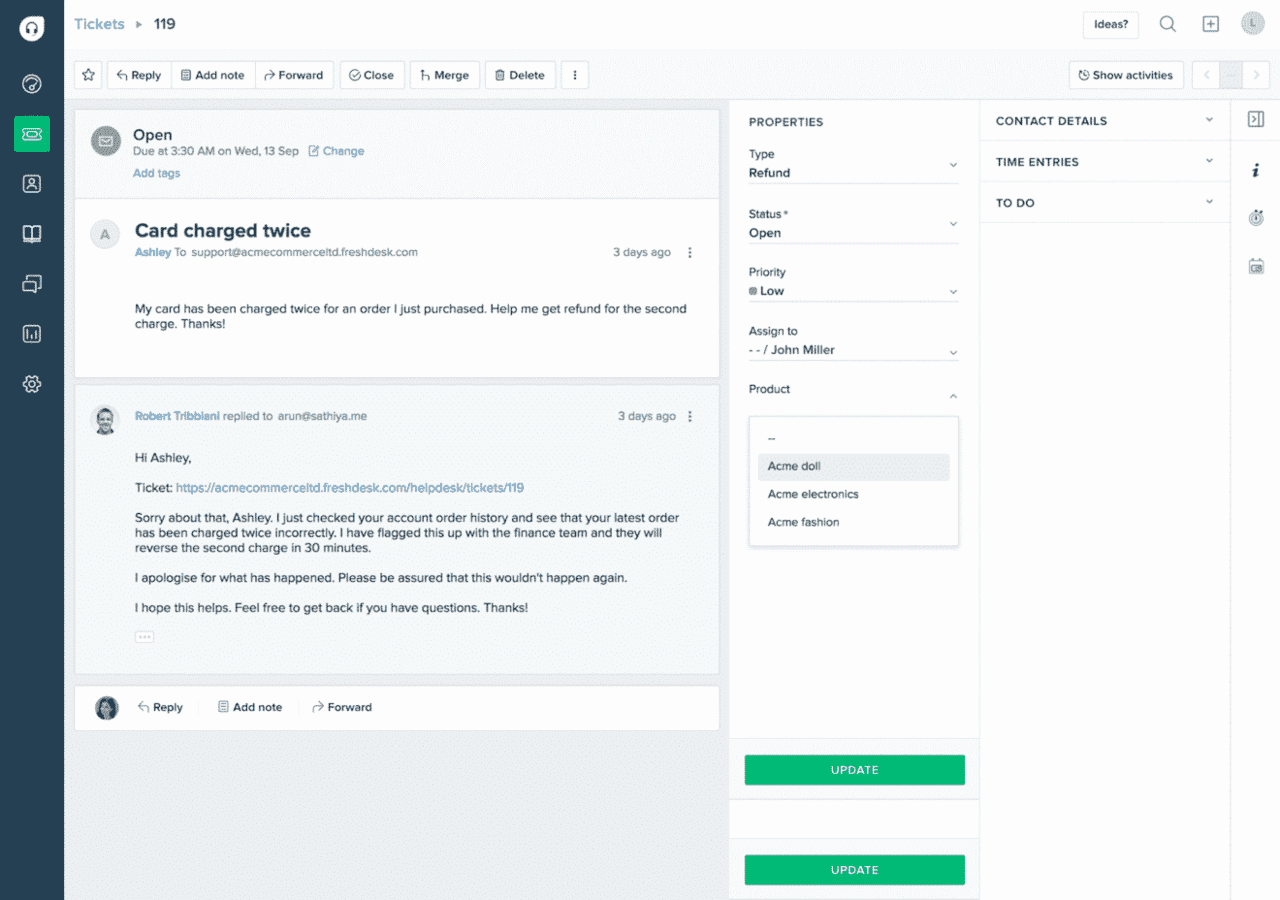
Freshdesk is part of a bigger suite of products called Freshworks. If you’re looking for a tool that offers marketing and sales features, it’s a good idea to check out the rest of the Freshworks suite. Using Freshworks alongside Freshdesk lets you connect various tools that handle specific tasks. However, it doesn’t quite feel like an all-in-one integration solution.
What Freshdesk offers:
- Ticket management for email support, including prioritization and auto-responders.
- Live chat widget for the help center.
- Omnichannel support for social media, so customers can contact you through their preferred method.
- Self-serve knowledge base.
- A customer forum and moderation tools so customers can connect with each other (and your support team.)
Pros:
- Automatic ticket assignment through a variety of criteria such as skill based or round robin.
- A more advanced live chat widget than some other solutions.
- AI assistance via bot so customers can get help right away even if all team members are busy.
- Omnichannel support includes social channels such as WhatsApp Business and Twitter.
Cons:
- Confusing pricing levels
- Some features are only available at higher price points.
- It’s not affordable for small - medium business or bootstrapping startups. Many basic features like team performance reports, social channels, and CSAT surveys cost $70 per seat or more.
- Enterprise level options mean more complexity and a steeper learning curve.
4. Help Scout
Help Scout is all about the customer centric approach and treating customers like “people, not tickets.” If you’re looking for Front competitors to help you focus more firmly on providing a delightful customer experience, Help Scout might be a good fit for you.
Help Scout’s features focus on managing support requests seamlessly, to keep customers happy. The product packs an excellent mix of collaboration, organization, and automation tools. Help Scout has a clean and user-friendly interface, without the steep learning curve of a bigger enterprise focused solution.
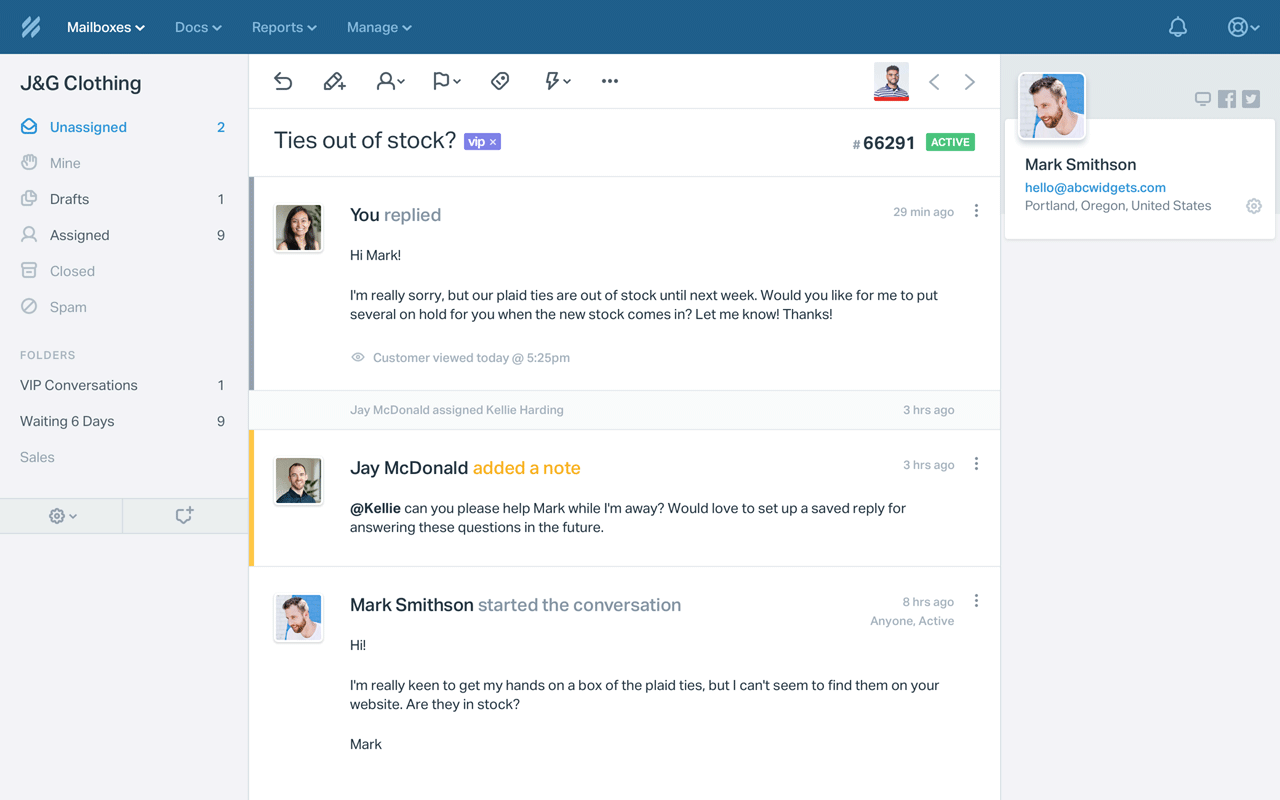
Help Scout promises a well-rounded customer support solution - and it delivers. However, like any software, it’s not one size fits all. There are some use cases that might not feel intuitive, depending on what your team needs.
Some workflows in Help Scout are either too restrictive for certain needs, or just not supported. For example, you can’t create custom folders based on a label. There isn’t an option to add another user’s email as a CC in a conversation. That’s not ideal for teams that frequently collaborate with members outside the regular support team to deal with issues.
What Help Scout offers:
- Shared inbox for easy team collaboration.
- A beacon widget with live chat messaging.
- Knowledge base so customers can find the help docs they need.
- Custom workflows and automation options.
- Insightful reports so you can monitor support interactions and results.
Pros:
- Nice straightforward and simple user interface.
- Advanced automations to help you customize your workflow.
- HIPAA compliant, so healthcare businesses can use it with confidence.
- Discounted price on your first year for non-profits and startups.
Cons:
- Organizing support tickets into folders feels inflexible. For example, there’s no option to create folders based on tags. Using tags to group requests is a super helpful feature for most teams, so the lack of it could cause unnecessary work for agents.
- Each mailbox is completely separate. It’s harder to bring conversations into one place.
- You can only add one ecommerce store for each single account.
- The ability to create different teams is only available on the higher priced plans.
5. Intercom
Intercom is one of the most popular Front competitors. Although it’s quite different from Front, it’s an ideal alternative for some teams. Intercom is strongly geared towards managing customer relations.
Intercom offers a flexible business messenger centered around proactive sales and marketing. Customers can also use the messenger to reach out to support staff. Other innovative Intercom features include custom bots, and product tours. It also offers in-app messaging for customers.
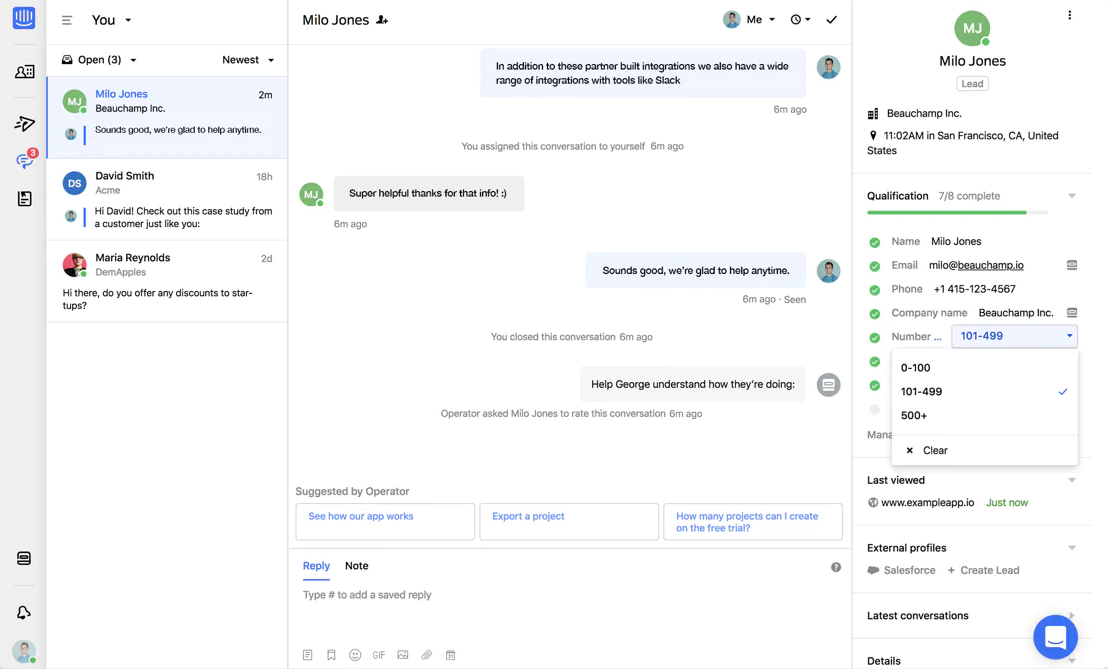
If you’re a SaaS business with a big sales / marketing budget, Intercom could be the right choice for you. The proactive sales tools, custom bots, and product tours help you engage customers and introduce them to your solution.
If your team needs customizable workflows, you might find the Intercom help desk isn’t robust enough. For ecommerce stores, where customers don’t interact with your app on a regular basis, Intercom’s messenger might cause confusion. It looks like a live chat but isn’t truly live, which may catch customers off guard.
If you’re a small startup, or bootstrapping right now, the steep pricing might put you off.
What Intercom offers:
- Email marketing campaigns based on customer segments.
- Business messenger with live chat and in-app messaging.
- Product tours and custom bots to engage customers.
- Manage support messages across channels.
- Self-serve support articles database.
- Reporting dashboard.
Pros:
- Clean and modern interface.
- Feature rich business messenger that has both marketing and support functions.
- You can use bots for advanced automation.
- Targeted outbound and proactive messages to clients.
Cons:
- Complicated pricing. Fees are based on both per agent seat, and number of customers. They used to have a price calculator to help customers figure out their cost, but now even that’s unavailable.
- It’s not any more affordable than Front. We had to do a bit of digging to find this. When you try to find pricing information, all you see is a “chat with us” option.
- Not as robust as some other solutions on this list, especially for email support management.
- Weaker analytics that don’t offer enough options to let you really drill down for deeper insights.
6. Kayako
Kayako offers a more traditional approach to managing customer support. Kayako gathers all communications with each customer across channels, and pulls them into a single long thread.
Kayako helps you provide a personalized customer support experience by bringing together events from external systems. Along with the messages across multiple channels, Kayako can show events like “customer made a purchase”, or “viewed an article on a knowledge base”.
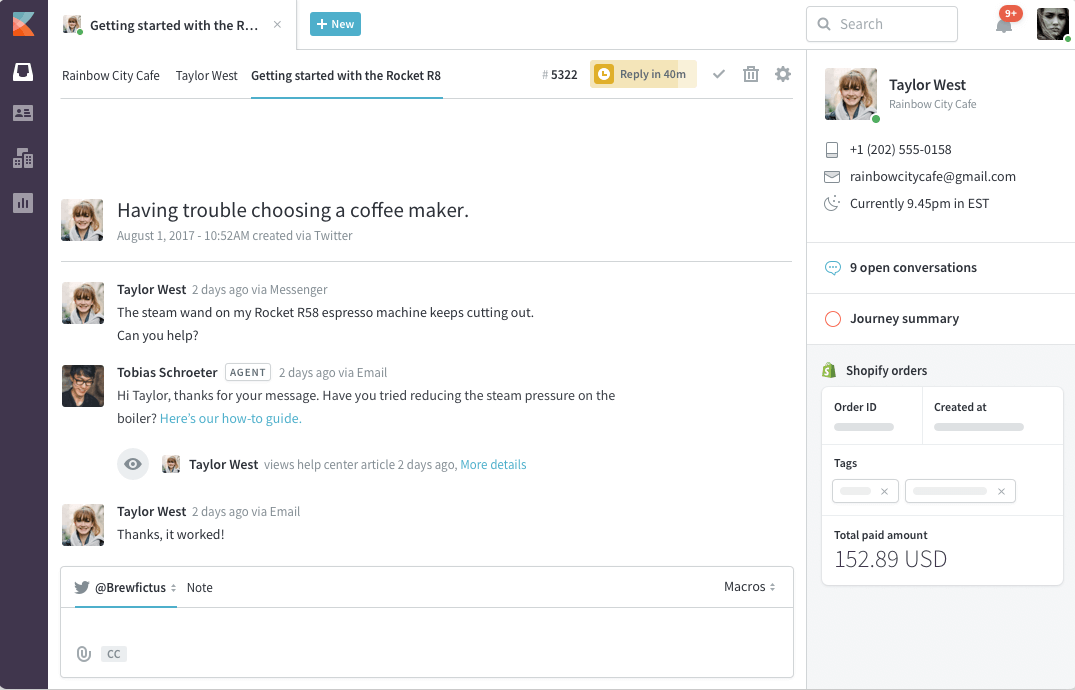
Although the commitment to keeping all communications in one place is fantastic, Kayako’s features aren’t up to par with Front’s. They revamped their solution in 2016 but it still doesn’t feel very modern or user friendly.
Kayako struggles with workflows. Even common help desk workflows are frustrating to set up. Say you want to set follow up reminders. With Kayako, you have to do the dance of adding a whole custom date field for when to follow up. Then you have to set up monitoring for that date field. It’s all too easy to squander precious time on all these fiddly little tasks.
What Kayako offers:
- Single view omnichannel communication, including social channels, purchases and knowledge base use.
- Advanced collaboration features.
- Self-service customer portal.
- Live chat widget.
- Native iOS and Android apps.
Pros:
- See the customer journey right alongside the conversation, so agents always have full context.
- Social integration is included even on the basic plan.
- Lets you collaborate internally with personnel from outside your customer support team.
- Simpler pricing plans than Zendesk or Freshdesk.
Cons:
- Poorer help desk functionality than Zendesk or Freshdesk.
- The forever single thread feature makes it harder to analyze individual interactions that customers have with different agents.
- Help desk customizations are only available at higher price points.
- No way to sort or search tickets by custom fields.
7. Reamaze
Reamaze was designed for businesses with online stores. If you’re an online retail business looking for a customer support solution, Reamaze could be the one for you. It integrates well with popular ecommerce solutions such as Shopify, WooCommerce and BigCommerce to bring in relevant information such as order details.
Reamaze also offers multi-channel support, including social media and live chat.
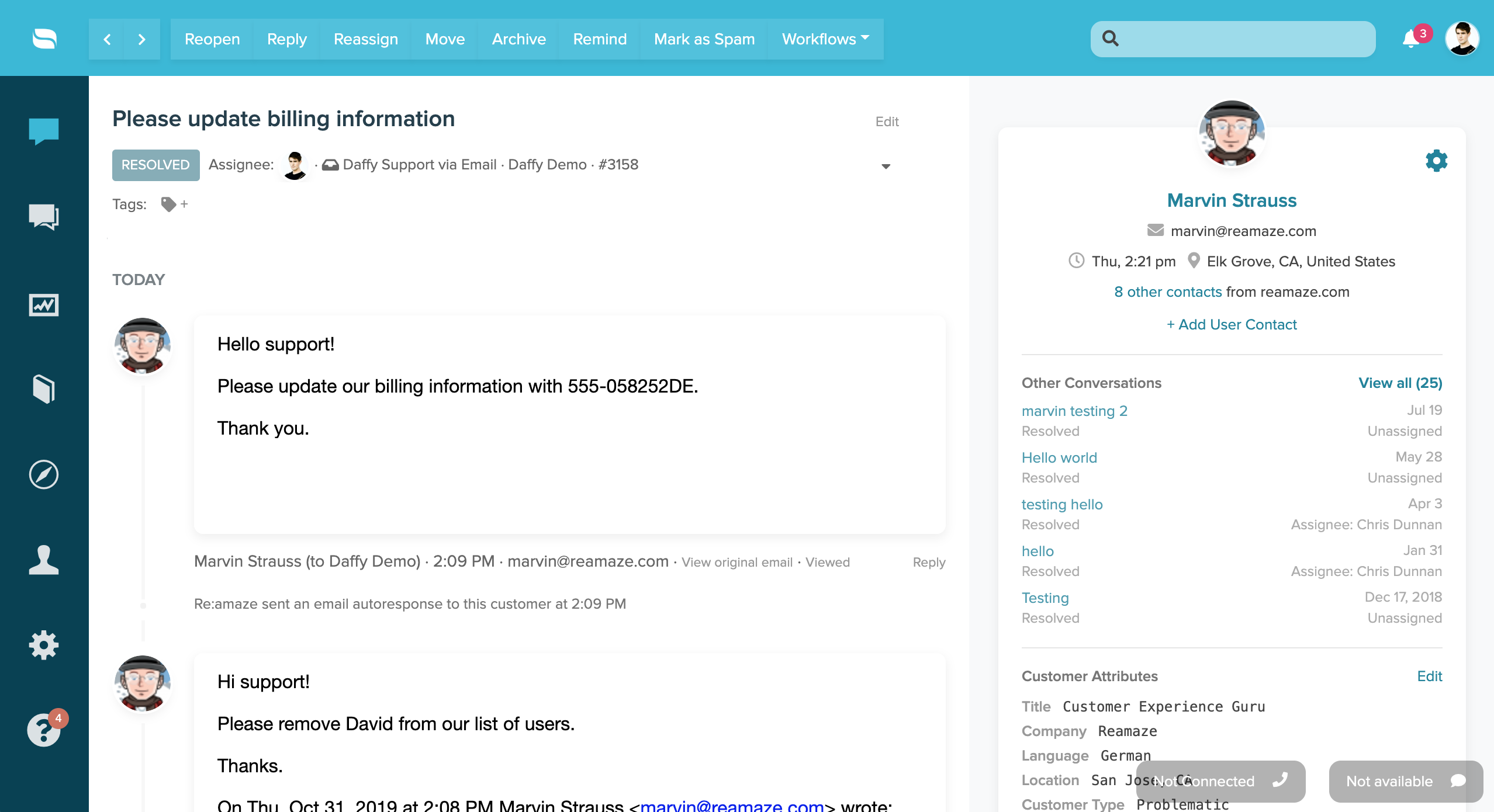
Reamaze is one of the best Front competitors for ecommerce businesses. Its deep ecommerce integration features, such as being able to give refunds for a Shopify store, make it a powerful tool. But if you need more robust handling of email, such as adding BCC recipients or classic email forward support, you might want to look at some of our other options in this list.
Some users feel that the reporting on certain data points could be better, too.
What Reamaze offers:
- Email based ticketing support.
- Omnichannel integration with social media.
- Robust integration with popular ecommerce tools.
- Live chat tool with chatbots.
- Customer community portal.
- A self-help FAQ center.
Pros:
- Deeper ecommerce integrations allow you to connect multiple stores to one help desk.
- Automated workflows based on customer intent make it easy for your agents to help customers at every stage of their journey.
- Customizable live chat with chatbots.
- Live view of site visitors on higher priced plans.
Cons:
- Weaker reporting of data points compared to some other solutions on this list.
- Some users report a poor experience when trying to like or share social messages.
- Other users report performance issues with the chat app.
- Attaching media such as images to the FAQ is not supported.
Conclusion
Great customer service doesn’t just affect customer loyalty. Businesses who offer great customer experiences can charge up to a 16% price premium on products and services.
When choosing a help desk or looking for Front alternatives, look for a solution that will support your agents to offer the best service. Ask which features your team most needs, and focus on finding a solution that offers those.
Businesses who offer great customer experiences can charge up to a 16% price premium on products and services.
Some products may make it easier to perform certain types of tasks while others might be more robust for certain types of industries. Certain solutions might still feel too bulky for your needs, while some might feel simpler yet flexible enough for your use case. Some might evolve faster than others, and some might offer better customer support than others.
The best Front alternative for your team is the one that offers just enough functionality that you need, with enough flexibility for your business to grow. Remember, the whole point is to have something that makes it easier to help your customers without feeling bulky or overly pricey.
If you need further help in choosing the best Front alternative, please see our detailed guide on how to choose a help desk.
At Enchant, we believe in delivering value to our customers without binding them into contracts. We also offer a free-of-cost and fully managed import of all conversations from Front. If Enchant's offering meets your needs, we recommend you try it out with your team today!